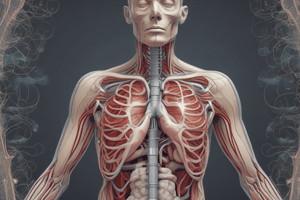Podcast
Questions and Answers
What is the normal clinical range of tidal volume?
What is the normal clinical range of tidal volume?
- 2000-3500 mls
- 300-650 mls (correct)
- 100-300 mls
- 750-1200 mls
What is the volume that can be inhaled maximally above tidal volume?
What is the volume that can be inhaled maximally above tidal volume?
- Expiratory reserve volume
- Vital capacity
- Inspiratory reserve volume (correct)
- Total lung capacity
What is the normal adult range of expiratory reserve volume?
What is the normal adult range of expiratory reserve volume?
- 1000-4000 mls
- 750-3000 mls (correct)
- 300-650 mls
- 2000-7000 mls
What is the formula to calculate vital capacity?
What is the formula to calculate vital capacity?
Why do normal values of lung volumes vary widely between individuals?
Why do normal values of lung volumes vary widely between individuals?
What is the purpose of flushing the spirometer with fresh room air between each set of measurements?
What is the purpose of flushing the spirometer with fresh room air between each set of measurements?
What is the device used to measure peak flow rate?
What is the device used to measure peak flow rate?
What is the importance of following safety precautions during lung function tests?
What is the importance of following safety precautions during lung function tests?
What is the maximum time allowed for each set of measurements?
What is the maximum time allowed for each set of measurements?
Why is it essential to refill the spirometer with fresh room air after each use?
Why is it essential to refill the spirometer with fresh room air after each use?
What should be done if the subject shows signs of distress during the experiment?
What should be done if the subject shows signs of distress during the experiment?
What is the role of the subject observer during the experiment?
What is the role of the subject observer during the experiment?
What is the primary purpose of using a nose-clip during the experiment?
What is the primary purpose of using a nose-clip during the experiment?
Why must the spirometer be freshly filled before connecting the subject?
Why must the spirometer be freshly filled before connecting the subject?
What is the minimum number of people required to conduct the experiment?
What is the minimum number of people required to conduct the experiment?
What is the purpose of having someone to flush the spirometer with fresh room air?
What is the purpose of having someone to flush the spirometer with fresh room air?
What factors significantly affect a person's FVC?
What factors significantly affect a person's FVC?
What is the normal range of FER in healthy individuals?
What is the normal range of FER in healthy individuals?
Which of the following is a characteristic of obstructive airways disease?
Which of the following is a characteristic of obstructive airways disease?
What is the purpose of short-acting beta-agonists (SABAs)?
What is the purpose of short-acting beta-agonists (SABAs)?
What is the normal range of FVC in a healthy individual?
What is the normal range of FVC in a healthy individual?
What is the diagnostic criterion for obstructive airways disease?
What is the diagnostic criterion for obstructive airways disease?
What is the indication for using a peak flow meter?
What is the indication for using a peak flow meter?
What is the consequence of using short-acting beta-agonists more than twice a week?
What is the consequence of using short-acting beta-agonists more than twice a week?
What is the primary function of salbutamol in the body?
What is the primary function of salbutamol in the body?
What is the purpose of taking LABAs on a daily basis?
What is the purpose of taking LABAs on a daily basis?
What is a characteristic of restrictive airways disease?
What is a characteristic of restrictive airways disease?
What is the name of the inhaler that uses a soft mist?
What is the name of the inhaler that uses a soft mist?
What is the name of the combination medication that contains formoterol and budesonide?
What is the name of the combination medication that contains formoterol and budesonide?
What is the purpose of combining LABAs with corticosteroids in the treatment of asthma?
What is the purpose of combining LABAs with corticosteroids in the treatment of asthma?
What is the typical range of Forced Vital Capacity (FVC) in liters?
What is the typical range of Forced Vital Capacity (FVC) in liters?
What percentage of FVC is FEV1 usually between?
What percentage of FVC is FEV1 usually between?
What is the calculation to find the Forced Expiratory Ratio (FER)?
What is the calculation to find the Forced Expiratory Ratio (FER)?
What is the clinical significance of a FER value less than 70%?
What is the clinical significance of a FER value less than 70%?
How is the Forced Expiratory Flow (FEF) 0.2-1.2 measured?
How is the Forced Expiratory Flow (FEF) 0.2-1.2 measured?
What is the purpose of using a peak flow meter?
What is the purpose of using a peak flow meter?
What is the correct procedure to use a peak flow meter?
What is the correct procedure to use a peak flow meter?
What is the significance of obtaining three readings for each subject using a peak flow meter?
What is the significance of obtaining three readings for each subject using a peak flow meter?
Flashcards are hidden until you start studying
Study Notes
Lung Volume
- A volume is a measurable quantity of gas expired from the lungs, while a capacity is composed of a number of volumes added together.
- Measuring volumes and capacities is part of lung function tests, which can give important clinical and experimental information.
Tidal Volume (TV)
- The amount of gas passing in or out of the lungs with each normal breath.
- Normal clinical range: 300-650 ml.
Inspiratory Reserve Volume (IRV)
- The amount of gas that can be inhaled maximally above tidal volume.
- Normal adult range: 1000-4000 ml.
Expiratory Reserve Volume (ERV)
- The volume that is maximally exhaled from the lungs after a tidal volume.
- Normal adult range: 750-3000 ml.
Vital Capacity (VC)
- The amount of gas that can be moved in/out the lungs between maximal inspiration and maximal expiration.
- Normal adult range: 2000-7000 ml.
- VC = IRV + ERV + TV
Factors Affecting Lung Volume
- Normal values vary widely between individuals and are affected by conditions such as athletic training, pregnancy, and respiratory diseases.
- Actual values depend heavily on body size and sex.
Equipment for Measuring Lung Volume
- Spirometer
- Peak flow meter
- Vitalograph
Safety Precautions
- Ensure the spirometer is flushed with fresh room air between each set of measurements.
- Each set of measurements should be less than 3 minutes.
- A fresh, clean mouthpiece must be used for each subject being tested.
- The spirometer must be refilled with fresh room air after a subject has used it.
- Someone must time measurements and watch the subject for signs of distress.
Vitalograph Analysis
- Forced Vital Capacity (FVC): the volume of air expired from the lungs during a forced expiration.
- Forced Expiratory Volume in 1 second (FEV1): the volume of air expired in the first second of a forced expiration.
- Forced Expiratory Ratio (FER): the percentage of FVC expired in the first second of a forced expiration.
- Forced Expiratory Flow (FEF 0.2-1.2): the average rate at which the first liter of air leaves the lungs during a forced expiration.
Peak Flow Meter Procedure
- Zero the pointer.
- Put a clean mouthpiece on the tube.
- Take a big breath, and then blow into the mouthpiece as hard and as fast as you can.
- Obtain 3 readings for each subject and take the average.
Respiratory Diseases
- Obstructive airways disease: characterized by a forced expiratory ratio (FEV1/FVC%) of less than 70%.
- Restrictive airways disease: characterized by poor distensibility and a decrease in vital capacity.
Treatment for Respiratory Diseases
- Bet a2-agonists (bronchodilators) for quick relief of asthma symptoms.
- Inhaled corticosteroids for chronic asthma management.
- Long-acting beta-agonists (LABAs) for daily use to relax muscles lining the airways.
- Combinations of LABAs and corticosteroids for asthma treatment.
Studying That Suits You
Use AI to generate personalized quizzes and flashcards to suit your learning preferences.





